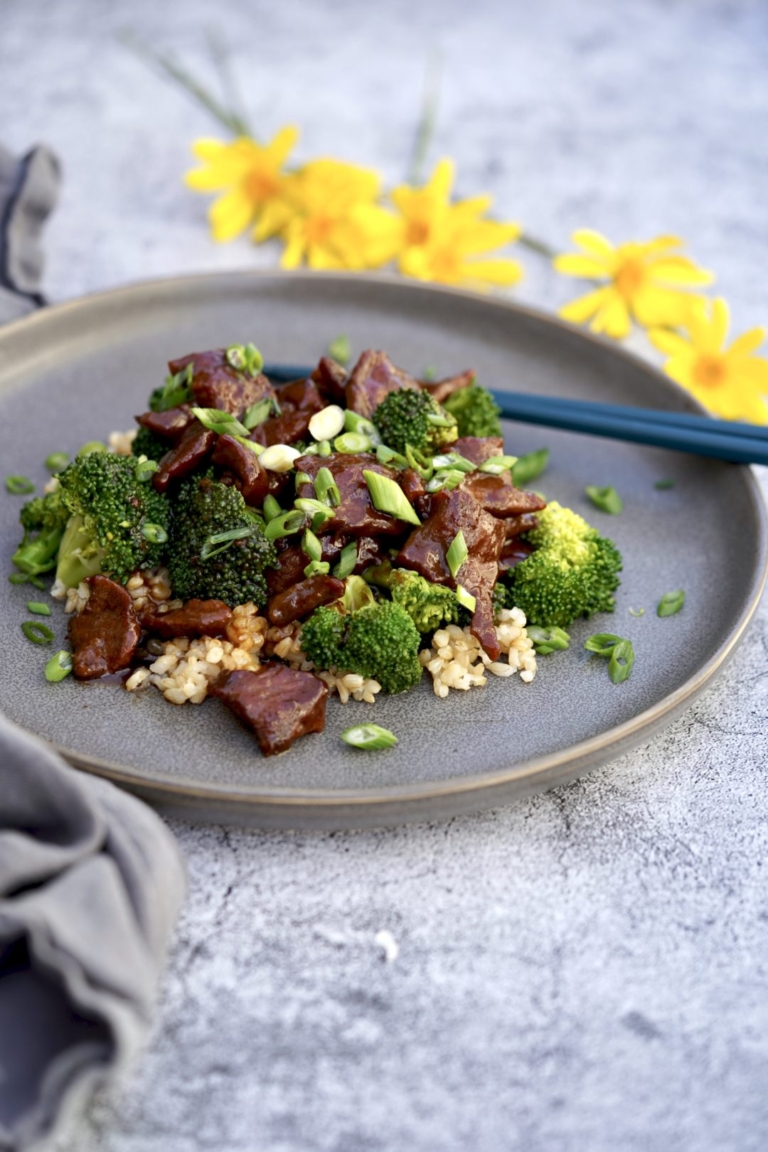
Beef With Broccoli
Beef with broccoli reminds me of my childhood. My mom never made it from scratch, but we ordered it often when we ordered Chinese food and it remains, to this day, a favorite. And while this beloved Chinese-American dish graces the menu of almost every Chinese restaurant I’ve been to over the years, I never knew the actual history of the dish, until now. Beef with broccoli, or broccoli beef, as it’s sometimes called, is believed to have been created by Chinese immigrants who arrived in San Francisco around the mid-1800s, during the California Gold Rush and the subsequent construction of the Transcontinental Railroad.
Gai Lan Chao Niu Rou
Making use of simple local ingredients, including American beef and new vegetables, like broccoli, the growing Chinese-American community created a new type of cuisine based on more traditional Chinese dishes. It is believed this iconic dish likely originated from a Chinese dish called Gai Lan Chao Niu Rou or “Chinese Broccoli Fried Beef“. However since early immigrants could not find Chinese broccoli in the States, American broccoli became a go-to substitute.
Chinese Exclusion Act of 1882
As the gold rush slowed, jobs in California quickly became scarce. Racial prejudice, and a fear that Chinese immigrants would undercut white wages, led to friction. Anti-Chinese sentiment culminated in the Chinese Exclusion Act of 1882. This was the only law in American history that prevented members of a designated ethnic group from immigrating to the United States. This law remained in effect until World War II.
45,000 Chinese Restaurants
Further legislation around that time prohibited this group from working in numerous industries. Workers were, however, permitted to work in food service. And this exception is what allowed many Chinese Americans to go into the restaurant business. Today an estimated 45,000 Chinese restaurants exist in the United States.
Restaurants were an economic lifeline for many Chinese-American families. Adapting traditional Chinese dishes, such as beef with broccoli, and catering to American tastes, allowed these families to prosper. During the 1900s, Chinese restaurants spread throughout the country and became known for inexpensive, fast, and satisfying food. Some historians believe this spread of the casual Chinese takeout restaurant is what likely paved the way towards a wider acceptance of Chinese Americans, but the motivation on the part of these immigrants is often overlooked. For many, opening a restaurant served as the only way to bypass laws designed to keep them out of the country.
I wanted to create a version of this well-known favorite to mark a memory in my childhood but also to note the historical aspect, which includes the reason for the proliferation and popularization of Chinese cuisine in the United States and the tenacity of the Chinese-American community that, I’m willing to bet, few know about.
Beef With Broccoli
Ingredients:
For the Beef:
- 1 pound, ideally grass-fed, flank steak, thinly sliced into bite-sized strips
- 1 tablespoon vegetable oil
- 4 cups broccoli, cut into small florets
For the Sauce:
- 1 1/2 teaspoons fresh ginger, grated
- 1 tablespoon garlic, grated
- 1/2 cup hot water
- 6 tablespoons low-sodium soy sauce
- 2 tablespoons light brown sugar
- 1 1/2 tablespoons cornstarch
- 1/4 teaspoon black pepper
- 1 1/2 tablespoons sesame oil
- 1 cup brown rice (optional)
Directions:
- For the Broccoli: Fill a large stockpot halfway with water, place over high heat, and bring to a boil. Once boiling, add the broccoli and blanch till vibrant green, about 1 minute. Drain and reserve.
- For the sauce: in a small bowl add the ginger, garlic, hot water, soy sauce, sugar, corn starch, ingredients in a bowl, stir well to dissolve the sugar, cornstarch, pepper, and sesame oil. whisk well to combine and set aside.
- Place a large skillet over high heat and add 1 tablespoon of oil. When hot, but not smoking, add the beef in a single layer and sauté until just cooked through, about 2 minutes.
- Add the sauce, reduce heat to medium/low, and simmer 3-4 minutes. It will thicken. Add broccoli and stir to combine. If the sauce is too thick, simply add 1 or 2 tablespoons of water to thin it out. Serve hot with brown rice.



